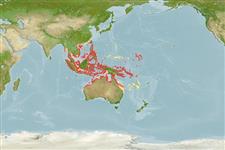Teleostei (teleosts) >
Eupercaria/misc (Various families in series Eupercaria) >
Nemipteridae (Threadfin breams, Whiptail breams)
Etymology: Scolopsis: Name from the Greek masculine noun 'skolos' meaning 'thorn' and suffix '-opsis' (from Greek feminine n. 'opsis' meaning 'aspect', 'appearance') meaning ‘thorny appearance’ presumably referring to 'les dentelures de la préopercule, en ont aussi, et même d'épineuses, aux sous-orbitaires' mentioned by Cuvier (1814) in his designation of the genus. Name ending in -'opsis' are treated as feminine according to ICZN 1999: Article 30.1.2 (Ref. 130620).
More on author: Cuvier.
Environment: milieu / climate zone / depth range / distribution range
Ecology
Marine; reef-associated; depth range 2 - 25 m (Ref. 9785). Tropical; 24°N - 27°S, 94°E - 172°E (Ref. 3810)
Western Pacific: South China Sea to Vanuatu and northwestern Australia.
Size / Weight / Age
Maturity: Lm ? range ? - ? cm
Max length : 28.0 cm TL male/unsexed; (Ref. 9710); common length : 15.0 cm SL male/unsexed; (Ref. 3810)
Dorsal spines (total): 10; Dorsal soft rays (total): 9; Anal spines: 3; Anal soft rays: 7. Head scales reaching to or almost to posterior nostrils. Lower limb of preopercle scaly. Antrorse (forward-directed) suborbital spine absent. Pelvic fins long, reaching almost to or beyond level of origin of anal fin. Color: Upper body olive, white below. 2 pearly white stripes on snout in front of eyes. Lower lobe of caudal fin reddish. Juveniles white, with a narrow black stripe along back (only on some specimens) and black midlateral stripe. Some with a yellowish ventral surface. Presence of a black spot between first four dorsal spines. Some color variation between Indian and Pacific populations: juveniles lack yellow stripe in the Indian Ocean population and adults show a contrasting dark back compared to Pacific form (Ref. 48635).
Found on sand bottoms close to reefs. Feed on crustaceans, polychaete worms, mollusks and small fishes (Ref. 3810, 9785). Juveniles may be Batesian mimics of poison-fang blennies, Meiacanthus spp. (M. geminatus and M. vittatus) (Ref. 37816, 90102). It is parasitised by the monogenean Anoplodiscus hutsonae on the pectoral fins and body surface (Ref. 124057).
Life cycle and mating behavior
Maturity | Reproduction | Spawning | Eggs | Fecundity | Larvae
Russell, B.C., 1990. FAO Species Catalogue. Vol. 12. Nemipterid fishes of the world. (Threadfin breams, whiptail breams, monocle breams, dwarf monocle breams, and coral breams). Family Nemipteridae. An annotated and illustrated catalogue of nemipterid species known to date. FAO Fish. Synop. 125(12):149p. Rome: FAO. (Ref. 3810)
IUCN Red List Status (Ref. 130435: Version 2024-1)
Threat to humans
Harmless
Human uses
Fisheries: subsistence fisheries
Tools
Can't connect to MySQL database fbquizv2. Errorcode: Too many connections
